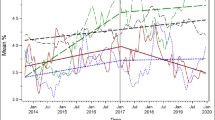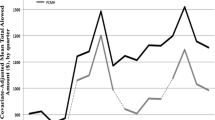Abstract
The Balanced Budget Act of 1997 dramatically changed the way that Medicare pays skilled nursing facilities, providing a natural experiment in nursing home behavior. Medicare payment policy (directed at short-stay residents) may have affected outcomes for long-stay, chronic-care residents if services for these residents were subsidized through cost-shifting prior to implementation of Medicare prospective payment for nursing homes. We link changes in both the form and level of Medicare payment at the facility level with changes in resident-level quality, as represented by pressure sores and urinary tract infections in Minimum Data Set (MDS) assessments. Results show that long-stay residents experienced increased adverse outcomes with the elimination of Medicare cost reimbursement.
Similar content being viewed by others
References
AHCA (2001). Facts and trends: The nursing facility sourcebook. Washington, DC: American Health Care Association
Ai C.R., Norton E.C. (2003). Interaction terms in logit and probit models. Economics Letters. 80(1): 123–129
Angelelli J., Gifford D., Intrator O., Gozalo P., Laliberte L., Mor V. (2002). Access to post-acute nursing home care before and after the BBA. Health Affairs. 21(5): 254–264
Castle N.G. (2000). Differences in nursing homes with increasing and decreasing use of physical restraints. Medical Care. 38(12): 1154–1163
CMS (2001). Phase II of final report to congress: Appropriateness of minimum nurse staffing ratios in nursing homes. Centers for Medicare and Medicaid Services (CMS).
Cohen J.W., Spector W.D. (1996) The effect of medicaid reimbursement on quality of care in nursing homes. Journal of Health Economics. 15(1): 23–48
Cutler D.M. (1995). The incidence of adverse medical outcomes under prospective payment. Econometrica. 63(1): 29–50
Davis M. (1991). On nursing home quality: A review and analysis. Medical Care Review. 48(2): 129–166
Dranove D. (1988). Pricing by non-profit institutions: The case of hospital cost-shifting. Journal of Health Economics. 7(1): 47–57
GAO (1999). Skilled nursing facilities: medicare payment changes require provider adjustment but maintain access.
Grabowski D.C. (2001a). Does an increase in the Medicaid reimbursement rate improve nursing home quality?. Journals of Gerontology Series B-Psychological Sciences and Social Sciences. 56(2): S84–S93
Grabowski D.C. (2001b). Medicaid reimbursement and the quality of nursing home care. Journal of Health Economics. 20(4): 549–569
Grabowski D.C., Feng Z., Intrator O., Mor V. (2004). Recent trends in state nursing home payment policies. Health Affairs. 23(4): W363–W373
Gruber J. (1994). The effects of competitive pressure on charity – hospital responses to price shopping in California. Journal of Health Economics. 13(2): 183–212
Harrington C., Zimmerman D., Karon S.L., Robinson J., Beutel P. (2000). Nursing home staffing and its relationship to deficiencies. Journals of Gerontology Series B-Psychological Sciences and Social Sciences. 55(5): S278–S287
IOM (1986). Improving the quality of care in nursing homes. C. o. N. H. R. Institute of Medicine. Washington, DC: National Academy Press
Johnson-Pawlson J., Infeld D. (1996). Nurse staffing and quality of care in nursing facilities. Journal of Gerontological Nursing. 22(8): 36–45
Konetzka R.T., Yi D.H., Norton E.C., Kilpatrick K.E. (2004). Effects of medicare payment changes on nursing home staffing and deficiencies. Health Services Research. 39(3): 463–487
Konetzka R.T., Norton E.C., Sloane P.D., Kilpatrick K.E., Stearns S.C. (2006). Medicare prospective payment and quality of care for long-stay nursing facility residents. Med Care. 44(3): 270–276
Lewin. (2000). Briefing chartbook on the effect of the Balanced Budget Act of 1997 and the Balanced Budget Refinement Act of 1999 on Medicare payments to skilled nursing facilities. Retrieved April 21, 2003, from http://www.ascp.com/public/ga/2000/pdfs/SNFBBACH.PDF.
McCall N., Korb J., Petersons A., Moore S. (2003). Reforming medicare payment: early effects of the 1997 Balanced Budget Act on post-acute care. Milbank Quarterly. 81(2): 277–303
Mehdizadeh, S., Applebaum, R. (2003). A ten-year look at Ohio’s long-term care system. Retrieved October 4, 2004, from www.scripts.muohio.edu/scripps.
Morris, J., Moore, T., Jones, R., Mor, V., Angelelli, J., Berg, K., et al. (2003). Validation of long-term and post-acute care quality indicators. Centers for Medicare and Medicaid Services (CMS).
Morris J.N., Fries B.E., Mehr D.R., Hawes C., Phillips C., Mor V., et al. (1994). MDS cognitive performance scale. Journals of Gerontology. 49(4): M174–M182
Norton E.C. (2000). Long-term care. In: Cuyler A. Newhouse J.(eds) Handbook of health economics Vol. 1A. Amsterdam, Elsevier Science, pp. 955–994
Norton E.C., Van Houtven C.H., Lindrooth R.C., Normand S.L.T., Dickey B. (2002). Does prospective payment reduce inpatient length of stay?. Health Economics. 11(5): 377–387
Nyman J.A. (1985). Prospective and cost-plus Medicaid reimbursement, excess Medicaid demand, and the quality of nursing-home care. Journal of Health Economics. 4(3): 237–259
Roadman C. (2000). Testimony before the senate select committee on aging. Washington, DC: American Health Care Association
Ross, M. (1999). Assessing the implications of the BBA in Medicare’s fee-for-service sector. In Testimony before the Subcommittee on Health and the Environment, Committee on Commerce, US House of Representatives. Washington, DC: MedPAC.
Scanlon W.J. (1980). A theory of the nursing home market. Inquiry. 17, 25–41
Troyer J.L. (2002). Cross-subsidization in nursing homes: Explaining rate differentials among payer types. Southern Economic Journal. 68(4): 750–773
White C. (2003). Rehabilitation therapy in skilled nursing facilities: Effects of Medicare’s new prospective payment system. Health Affairs. 22(3): 214–223
White C. (2005–2006). Medicare’s prospective payment system for skilled nursing facilities: Effects on staffing and quality of care. Inquiry. 42(4): 351–366
Wodchis W.P., Fries B.E., Hirth R.A. (2004–2005) The effect of Medicare’s prospective payment system on discharge outcomes of skilled nursing facility residents. Inquiry. 41(4): 418–434
Wodchis W.P. (2004). Physical rehabilitation following Medicare prospective payment for skilled nursing facilities. Health Services Research. 39(5): 1299–1318
Wunderlich, G., & Kohler, P. (Eds.) (2000). Improving the quality of long-term care. Committee on Improving Quality in Long-Term Care, Division of Health Care Services, Institute of Medicine. Washington, DC: National Academy of Sciences.
Zhang X.Z., Grabowski D.C. (2004). Nursing home staffing and quality under the Nursing Home Reform Act. Gerontologist. 44(1): 13–23
Zimmerman D., Karon S.L., Arling G., Clark B., Collins T., Ross R., et al. (1995). Development and testing of nursing home quality indicators. Health Care Financing Review. 16(4): 107–127
Zwanziger J., Melnick G.A., Bamezai A. (2000). The effect of selective contracting on hospital costs and revenues. Health Services Research. 35(4): 849–867
Author information
Authors and Affiliations
Corresponding author
Rights and permissions
About this article
Cite this article
Konetzka, R.T., Norton, E.C. & Stearns, S.C. Medicare payment changes and nursing home quality: effects on long-stay residents. Int J Health Care Finance Econ 6, 173–189 (2006). https://doi.org/10.1007/s10754-006-9000-9
Received:
Revised:
Accepted:
Published:
Issue Date:
DOI: https://doi.org/10.1007/s10754-006-9000-9




